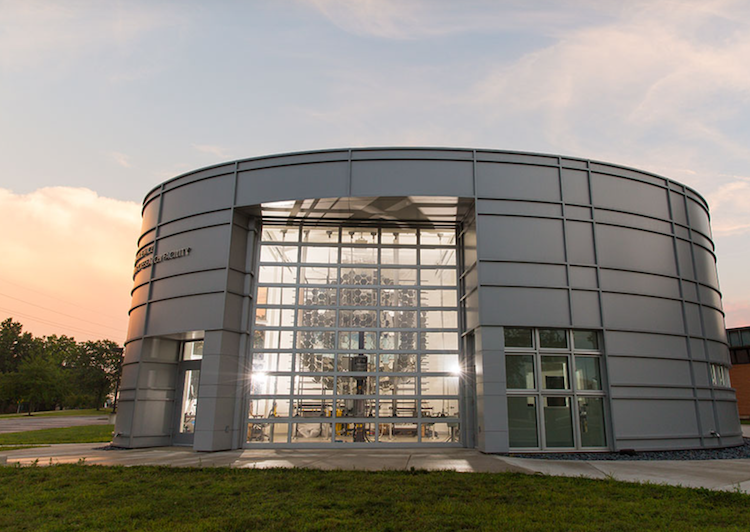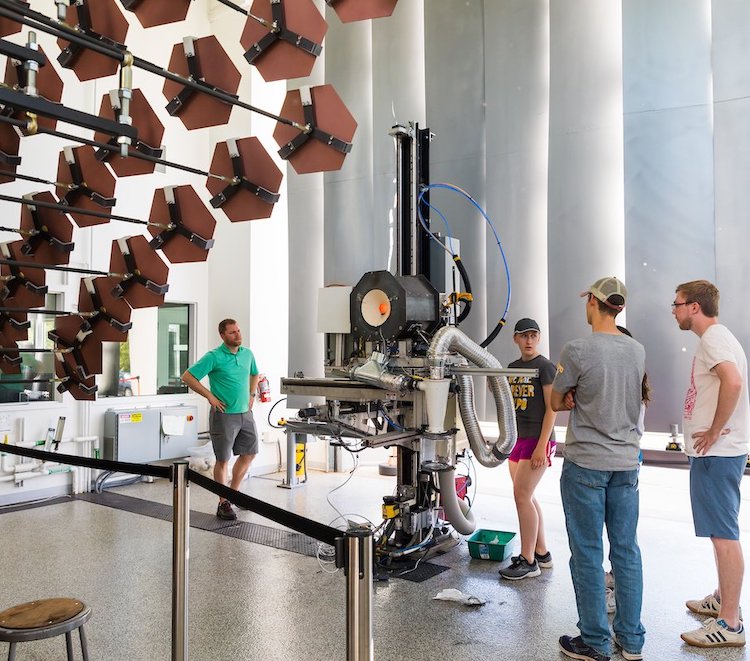IMAGE©Valparaiso University The solar lab at Valparaiso University: This solar furnace uses a horizontal, on-axis optical configuration. A heliostat reflects solar radiation into a faceted, spherical concentrator comprising 305 hexagonal mirrors. The concentrator has a focal length of 5.77 m and a rim angle of approximately 20°. It focuses the radiation to an approximately 6 cm diameter focal spot, which matches the aperture of the solar reactor.
Three and a half years after a group of undergraduate researchers at Indiana’s Valparaiso University stored heat at 1000°C, they have extracted the heat in a proof of concept demonstration of the extremely long-duration potential of the redox cycle for solar thermochemical storage. (How solar thermochemistry works)
After storing reduced cobalt at room temperature for three and a half years, the re-oxidized material could be used to supply process heat directly or produce hydrogen with electrolysis by electrochemically oxidizing the cobalt in water.
Their paper, Fungible, Multiyear Solar Thermochemical Energy Storage Demonstrated via the Cobalt Oxide Cycle, was published in the Journal of Solar Energy Engineering in April 2024.
The idea that solar heat stored as chemical energy can be stored for long periods is not new, and this aspect of solar thermochemistry has been used in many redox reactions — including ceria and copper — which have already begun to generate startups to completely decarbonize commercial aviation and mining. But the Valparaiso University study with cobalt is the first time the concept has been demonstrated over multiple years.
“Our prototype receiver enabled solar-to-stored-chemical-energy efficiency as high as 20%,” said Peter Krenzke Ph.D., Assistant Professor of Mechanical Engineering and Bioengineering at Valparaiso University, who led the research. “We would anticipate higher efficiency with a better-insulated reactor at larger, commercial scale,”
How the demonstration worked
The team designed and built a 4-kW solar reactor that uses metal oxide reduction-reoxidation cycles to capture and store solar energy. In the summer of 2019, researchers loaded room-temperature Cobalt oxide (Co3O4) particles into the reactor’s hopper. Then they heated the particles for one to two hours to 1,000°C in the solar furnace at the Valparaiso University James S. Markiewicz Solar Energy Research Facility.
The on-sun experiments allowed the researchers to test the performance of their solar reactor in reducing cobalt oxide particles at different feed rates to optimize the conversion and efficiency of the charging step. The heat from the solar furnace focusing concentrated solar thermal energy (CST) activated the reduction of oxygen leaving the reduced cobalt (CoO).
This was stored at room temperature until January of 2023 when the researchers reoxidized the particles, re-creating the initial cobalt oxide (Co3O4) which can then be used to restart the cycle.

IMAGE©Valparaiso University – Undergraduate students calibrating the solar reactor at Valparaiso University
Two ways of retrieving the stored energy were analyzed
“Broadly, the appeal of chemical energy storage is that the stored energy is stable and can be used flexibly,” Krenzke said. The obvious way would be to extract the energy as sensible heat. The reduced cobalt oxide (CoO) can be reacted with hot air, releasing energy that is transferred to the air as heat.
This heat can then be used to power high-efficiency power cycles like supercritical CO2 Brayton cycles. To demonstrate the release of stored solar energy as process heat, the sample was heated in a quartz tube under a constant air flow.
Krenzke listed the issues they encountered extracting the stored energy as sensible heat.
“If we store at room temperature but extract the stored energy as process heat, the sensible heat required to heat the reactants from room temperature to 800°C is roughly 75% of the chemical energy stored in the oxide,” he explained.
“But this is the worst-case scenario for extracting process heat. This discharge mode becomes more appealing if the particles are already stored at a high temperature coming from the receiver. The question then becomes how long the particles can be stored at elevated temperatures. A 2022 study led by Zhiwen Ma shows a well-insulated containment structure can maintain particles for five days near 1200°C with only a 2% loss of stored thermal energy. Reheating the particles to 800°C would still leave 71% of the chemical energy stored for use as process heat.”
The second option holds promise
However, they also investigated using the resulting cobalt to produce hydrogen through electrochemical electrolysis in water. “The hydrogen production option is clearer for the long-duration storage. It is really our preferred concept,” Professor Krenzke said.
They found that the electrochemical hydrogen production method would have an advantage over today’s water electrolysis hydrogen production: It would be more efficient.
Rachel Silcox, who has gone on to do a Ph.D. in electrochemical processes, worked on the team as an undergrad and explained the advantage.
“Today’s proton exchange membrane – PEM is a type of electrolyzer that you can buy, that runs on electricity, but it is very energy intensive,” she noted.
“That’s because you are producing oxygen as a byproduct of trying to produce hydrogen. This normal water electrolysis should take place at 1.23 volts. Instead, we can produce hydrogen with a much smaller electrical input than you would using a PV electrolysis system. Our electricity demand is much less, at 0.55 volts.”

IMAGE©Valparaiso University Valparaiso University solar laboratory
Valparaiso University has the only undergrad-level solar furnace in the US
Despite Indiana’s relatively low solar resource (Valparaiso’s annual DNI is around 1,430 kWh per square meter) Valparaiso University is the only undergraduate institute in the US with a solar furnace, making it ideal for getting started in solar thermochemistry research.
“We were able to achieve a very high temperature due to the high concentration ratios of our solar furnace, I believe it was 3,000 suns,” said Silcox.
However, the solar reactor itself is open-window style. This restricts what materials could be investigated.
“Part of the draw of using the cobalt oxide was that it would reduce at a low enough temperature where you could have it still exposed to air,” she explained.
“And by low enough, I still mean 1,000 degrees Celsius, so it’s still very hot, but you could expose it to air, and then you save the capital-intensive step of getting a window and having an oxygen-free environment. For instance, a material like iron oxide would be ideal because it’s just rust, but it may have needed a window, which was difficult. The electrochemical process of getting the energy back out was also problematic compared to cobalt. ”
Professor Krenzke confirmed that the temperature limit ruled out other redox materials for the demonstration. “Ceria is challenging because the reduction temperature is higher, near 1500°C, and the sensible energy required for heating is more significant relative to the chemical energy storage,” he said.
So, the group settled on cobalt as a demonstration of the concept, despite its non-viability as a commercial option with environmental and safety hazards.
“I think if it were commercially done, we would have to look at a material other than cobalt oxide because there are risks, but also it’s very expensive,” said Silcox, who is now doing her PhD in the mechanical engineering department at the University of Michigan.
“Even the battery community is trying to take cobalt out of their electrodes. So, we wouldn’t want to start this at a commercial scale with cobalt. But the cobalt oxide serves to demonstrate that this could be done,”
Professor Krenzke was happy to hear of his former undergrad’s continued research: “We have enjoyed seeing our Valpo solar research alumni, like Rachel, continue to work toward sustainable energy solutions. While we try to maintain a quality research program, our primary goal is to send our students out prepared to lead and serve as they tackle challenges of their own,” he said.
A solar sulphur cycle to make unlimited thermal energy storage
Solar furnace to melt steel at 2000°C for Swiss recycler Panatère
Thermochemical energy storage to deliver Gen3 solar 365 days/yr
The post Valparaiso University undergrads demonstrate multi-year thermochemical energy storage appeared first on SolarPACES.


